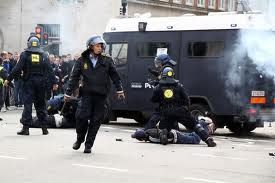When the aggressive Irish Patrick Hooligan torn his surroundings with drinking, fighting and thefts in the 1800 was he little aware of the fact that he would put name to the violent subculture for rabid football fans according to writer Clarence Rooks in Hooligan Nights.
As Liverpool manager Bill Shankly once said,” football is not a matter of life and death, it’s much more important that that.”
It is a lifestyle and a case of honour. This English hooligan culture gave them a bad reputation after exclusions from other European stadium, which took them a long time to recover from.
The English firms made gentlemen agreements for how the fights would be done and situated. The rules were agreed and the fights would then go on until one group was defeated which gave good reputation to the winning team.
Hooliganism is known as the “English sickness.” This refers to the organised football related violence between rival football fans, which mostly have originated in England and after episodes with English fans around in Europe. Vandalism and vandalism is one of the major aspects of their actions, which make the notorious reputation what it is. It originated around 1985 in England and evolved across borders as football became more popular.
A person can have different grader of emotional involvement, which can be, vary. It is not a stationary and insensitive relation, that a person during a match can be varied between emotional involvements. This engagement is different from fan to fan and how much football are a part of your everyday and the age of the person. The behaviour can vary from the applauding to a constant engagement and involvement in common actions.
Amount of emotional involvement
Spectator
Fan
- roligan
Supporter
- ultras
- casuals
- hooligan
In the Danish support culture only Brondby football has a paid president, where all others are voluntary and the support groups earn money through membership and souvenirs.
The biggest role of the president is to agree on guidelines for what behaviour is allowed. The president also arranges buses for away games and parties. The members of the groups are mostly youngsters with the average age on 22 where most are men. The more shocking aspect is that whole 15 percent are female which is very uncommon in other countries.
Many people have the prejudice that supporters come from the working class, but the supports occupational composition goes against that. Half of the supporters live at their parents, which makes them economically independent.
p. 25 table.
Parents jobs in percentage
--- Father - Mother
Studying o% - 2%
Uneducated worker 6% - 12%
Educated worker 26% - 16%
Lower functionary/official 7% - 18%
Higher functionary/official 29% - 23%
Independent 17% - 10%
Unemployed 15% - 19%
(N=376 and 388) 100% - 100%
According to Peter Grønlund, football specialist and author, believe the 4 elements: atmosphere, community, lifestyle, identity and rituals and myths, is what makes support groups attractive. The mood experiences and the community can be seen as direct motifs to become a supporter whilst lifestyle/identity and rituals /myths can be seen as sub-elements. The lifestyle is the engagement as supporter whilst the rituals confirms the community and therefore enhances the mood experiences. These aspects connect together independent from each other.
65 percent of supporters prefer to attend a match where their team is loosing but the atmosphere is good instead of the other way around. The new members are more focused on the atmosphere than the once that have been their longer who is more into the match. This counts especially of r lower or higher functionaries.
You could say that the supporters override there won personality at the same time as the personal identity floats together with the others and therefore creates a collective identity.
The modern peoples challenges right now is to create your identity. The society is characterized by a individualising process, where everybody a higher number of individual opportunities to realise your own life project. To conclude, the supporters could choose to be supporters or not, just as they can decide how big a part of their life it will take. The economic boundaries aren’t big and everybody have a possibility to become a supporter.
The community they mostly seek is the wide community where they only meet with the other supporters at the matches. Today we mostly seek communities a short period of time because we mostly go from one community to another because we choose communities where we can accomplish something. People seek a rush in the supporter culture or at least something different from the everyday.
As a replacement for the traditional social relations in family religion and politics, new communities are created. Through the close and intimate relations to other supporters, obtains the single individual a form for personal satisfaction, which helps them feel secure. We all need people we can trust and to obtain personal confidence it is necessary to open you to others, which is best obtain by exhibit warmth and openness. We share our identity and intimate with others and if this bond is broken consequences will be severe.
 Brondby Stadium "Vilfort Park"
Brondby Stadium "Vilfort Park"
 As you can tell, the work is plentiful.
As you can tell, the work is plentiful. The Brondby logo flying to top.
The Brondby logo flying to top.









